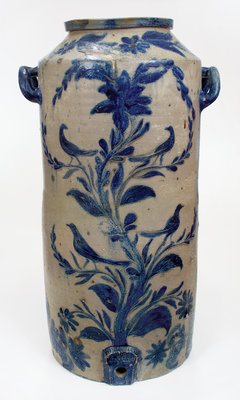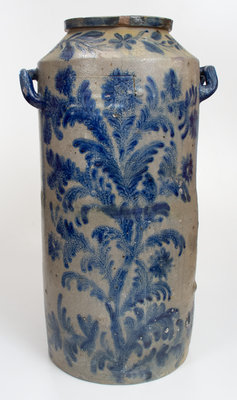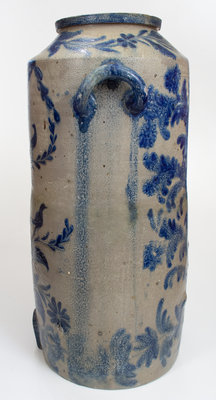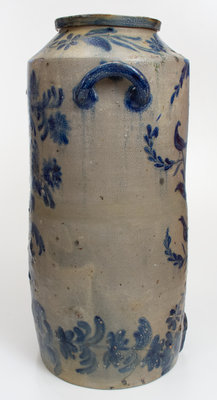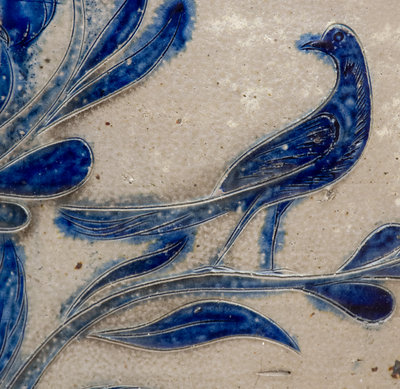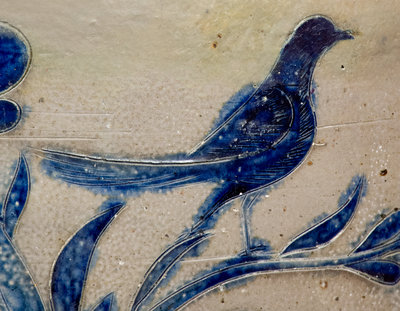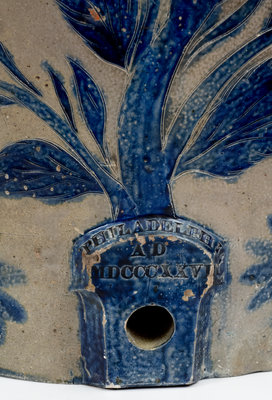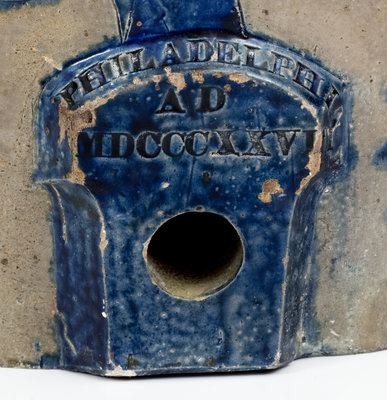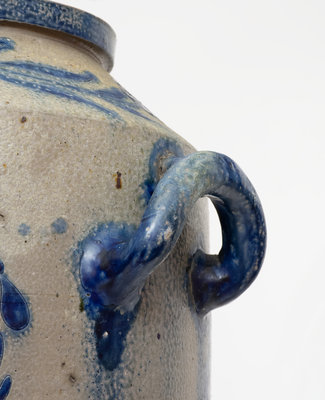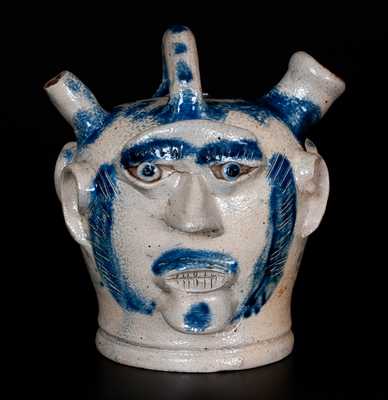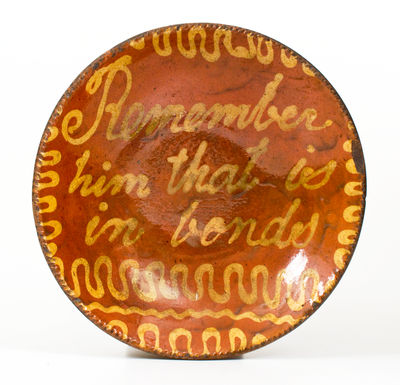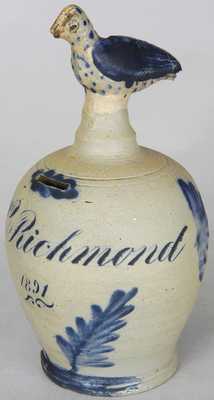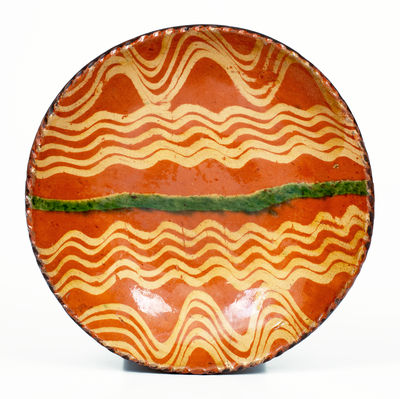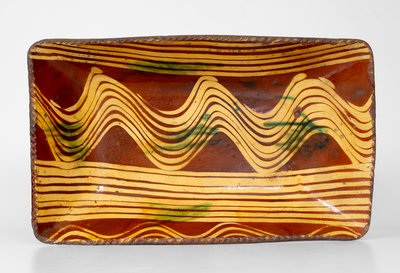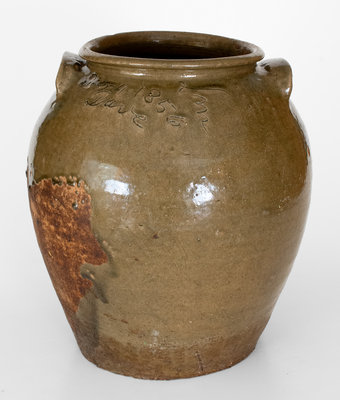Highly Important Twenty-Gallon Cobalt-Decorated Stoneware Water Cooler with Profuse Incised Bird and Flowering Plant Motif and Brushed Flowering Plant Motifs, Stamped "PHILADELPHIA / A D / MDCCCXXVIII" and "JK," attributed to Henry Remmey, Jr., Philadelphia, PA, 1828, cylindrical form, wheel-thrown in two sections, with tapered shoulder, squared rim, triple-terminal handles, and bunghole sculpted into a stylized flowerpot; front decorated with a base-to-shoulder incised and cobalt-highlighted design of a large flowering plant bearing daisies, numerous leaves, and a central pointed-petaled flower, four of the plant's stems bearing two pairs of facing and opposing birds. Incised details appear throughout the birds' wings and the interiors of the leaves in the distinctive Remmey style. Cobalt-decorated bunghole features the impressed inscription, "PHILADELPHIA / A D/ MDCCCXXVIII." Reverse brush-decorated from base to shoulder with an extravagant design of a blossoming daisy plant. Elaborate incised daisy motif to shoulder. Brushed daisy motif around base. Cobalt highlights to rim and handles. Proper right handle impressed "J K" at the two widest terminals. Among the most lavishly decorated early American ceramic objects known, this extraordinary creation ranks as THE masterwork of Remmey family stoneware produced in America. Imposing in its proportions, the cooler reveals Henry Remmey, Jr.'s abilities as a master of his medium as both a potter and decorator. While showcasing the incised decorative treatment of his birthplace, Manhattan, in its over-the-top flowering plant bearing four birds, the cooler also displays a growing change in style throughout the Mid-Atlantic stoneware school in its exuberant brushwork on the reverse. Clearly made as a statement piece just one year after Remmey's arrival in Philadelphia (after working with his father for fifteen years in Baltimore) the cooler's cleverly-sculpted bunghole proudly touts the name of the potter's new city of production. The highly unusual Roman numeral date, "AD / MDCCCXXVIII," also impressed on the bunghole, highlights the import of this work--a classically inspired monument in clay--to Remmey's oeuvre. The initials, "J K," found on one handle may refer to the cooler's owner. Superlatives cannot adequately express the significance of this object as a work of both ceramic art and a piece emblematic of the American style of stoneware production. It is easily the largest documented piece of cobalt-decorated stoneware by any member of the Remmey family, the largest freehand-decorated stoneware piece produced in the Eastern half of the state of Pennsylvania, and among the tallest examples of American cobalt-decorated stoneware known. Either side features masterwork-level decoration in their respective mediums, whether the refined freehand incising on the front or the brushed cobalt-slip application on the reverse. Approximate measurement of the vessel's volume indicates an astounding twenty gallon capacity. A much-smaller, related cooler depicting two birds is currently on display at the Philadelphia Museum of Art. Recently discovered, the cooler includes some professional restoration to damage, most or all of which was incurred during the firing. As salt glazing was found on the breaks on this cooler when found, this piece was damaged in the firing, but likely kept because of the amount of effort put into its creation. Restoration around midsection of cooler at the juncture of the two separately thrown sections. Restoration to approximately 2/3 of underside. This restoration extends as an approximately 1 3/4" tall section around base of cooler, running from the area to the right of the bunghole onto reverse. A horizontal crack extends off of this restoration onto reverse/side of cooler. Some wear to handles and bunghole. Some in-the-firing bubbling to clay. A thin 5 1/2" crack from rim on front. A 2 1/2" flake to top of rim, possibly in-the-making. A 1 1/2" rim chip on reverse, which is glazed over. Other minor chipping to rim. Typical in-the-firing surface flaws, including contact marks to shoulder. H 33".
Special Note: Due to this object's large size, we are unable to ship it using our normal in-house shipping service. It must either be picked up by the high bidder, or special arrangements must be made by the high bidder for pick up and / or shipping by a third party. If you have any questions, please contact us; we are certainly able to recommend options for third party shippers ahead of time that you can contact for a quote.

